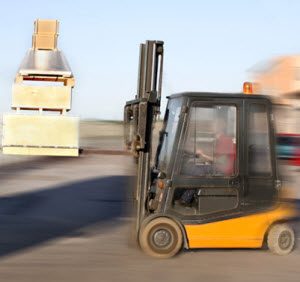Recently, a subscriber asked the following question:
Can we use a work platform connected to a fork truck to lift employees? If yes what are the regulations?

This was our answer:
The general industry standard for forklifts at 29 CFR 1910.178 does not directly address the use of work platforms to lift employees. OSHA has indirectly addressed the issue in several interpretation letters. In one interpretation letter of the rule, OSHA considers work platforms to be “removable attachments.” In another letter, “when occasionally using forklift trucks to elevate personnel on a secured safety platform…the employer must follow the requirements of 1910.178.” A third OSHA letter provides more detail about attachments in general: written approval from the manufacturer of a powered industrial truck is required for modifications and/or additions if the modifications and/or additions affect the capacity and safe operation of the truck. However, an alternative to manufacturer’s approval is if the employer has obtained written approval from a qualified Registered Professional Engineer after receiving no response or a negative response from the powered industrial truck manufacturer. If the manufacturer’s response was negative, then the engineer, prior to granting approval for the modification or addition, would need to perform a safety analysis and address all safety and/or structural issues contained in the manufacturer’s disapproval.
An employer’s failure to prevent or correct, to the extent feasible, fall hazards from elevated work platforms might be citable as a violation of the General Duty Clause, Section 5(a)(1) of the OSH Act. OSHA’s evaluation of the existence of a serious, recognized hazard and the availability of feasible means of abatement would include consideration of the relevant provisions of the ASME B56.1 standard, (ASME) Safety Standard for Low Lift and High Lift Trucks.
Lifting personnel on forklifts at construction sites. Under OSHA’s forklift rule for construction at 29 CFR 1926.602, work platforms connected to a fork truck are permitted for lifting employees under certain conditions. The OSHA rule for forklifts at construction sites at 29 CFR 1926.602(c)says trucks with lifting carriages or forks for lifting personnel must use a safety platform firmly secured to the lifting carriage or forks. Means must be provided so personnel on the platform can shut off power to the truck, and protection from falling objects must be provided.
However, under 29 CFR 1926.451 for scaffolds, if the manufacturer’s operator manual states that a forklift is not to be used for elevating personnel platforms, use of the equipment to support such a p
latform would violate this rule. Consequently, OSHA prohibits the use of such equipment to elevate personnel. If the owner’s manual for the equipment is silent on whether the equipment may be used to elevate personnel, the employer must determine if the forklift was designed for such purposes. The standard places the obligation on the employer to ensure that this type of equipment is used to elevate personnel only where the manufacturer has designed it to do so. The employer would either have to find out from the manufacturer that it was designed for this use or (where that information is unavailable) obtain a certification by a registered professional engineer that the equipment was so designed.
Rough terrain forklifts shall not be used to lift personnel unless there is no other practical option. Users shall ensure that the platform complies with design requirements listed in ANSI/ITSDF Part III, For the Manufacturer and follow all precautions in ANSI/ITSDF B56.6-2011, 5.15 Elevating Personnel.
